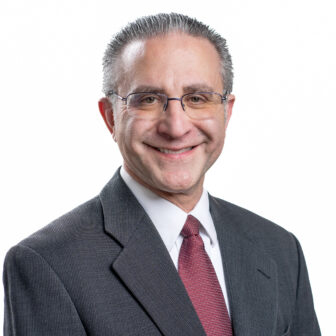With a news service on the way, an organization supporting Minnesota radio stations continues to grow

Anthony Nichols
Ampers member station KBFT broadcasts live from the Minnesota State Fair.
The Association of Minnesota Public Educational Radio Stations, once a small collective tasked with lobbying the state’s government to fund community stations, is aiming to expand its news offerings after dramatically growing its revenue in recent years.
Ampers is now a $1 million–plus operation that helps 18 member stations “not only survive but ideally thrive,” said CEO Joel Glaser. It supports stations through a mix of programming, underwriting and lobbying for state funding.
Ampers is now on the cusp of securing a one-time $1.2 million appropriation from the state of Minnesota to fund a news service that would serve diverse communities throughout the state. Gov. Tim Walz included the funding in his budget recommendations, and bills that include the support are currently working through the legislature.
The news service would feature members of Minnesota’s diverse communities telling “untold stories” from those communities, which include BIPOC, rural and disability communities, Glaser said. If funded, it will start as a daily newscast and eventually add a weekly 30-minute newscast. The newscasts will be offered in different languages.
The state funding would complement $150,000 Ampers has already raised from the McKnight Foundation. The project’s first phase could launch as early as this summer, Glaser said.

Many Ampers members are smaller community stations that lack news departments, Glaser said. “So we knew that there was a need for news, but there was a need for news from a diverse perspective and from a different perspective other than the dominant culture,” he said.
The plan is for Ampers to hire a full-time news director and probably contract reporters and producers as well. Glaser hopes the initiative will incorporate training for the producers and reporters.
If fully realized, the project would require about $1 million annually. Ampers plans to hire a development director and raise money to support the project.
“It’s a very big lift, an organizational-changing lift, but also a very needed product and project for the citizens of Minnesota,” Glaser said.
‘So much potential’
The programming Ampers offers to member stations already includes shows such as Minnesota Native News, a weekly five-minute newscast centered on Minnesota’s Native communities that debuted in 2014. Out of MNN grew Native Lights: Where Indigenous Voices Shine, a weekly podcast and 30-minute radio program that shares stories of people in Native communities.
The forthcoming diverse news initiative grows out of Racial Reckoning, a journalism project launched by Ampers, KMOJ in Minneapolis and the Minnesota Humanities Center in 2021. It offered daily and weekly updates for Ampers stations during the trial of Derek Chauvin, the police officer who killed George Floyd. It later covered the trial of Kim Potter, the former police officer who shot and killed Daunte Wright during a traffic stop outside Minneapolis. Stations could also use translations in Hmong, Somali and Spanish, and a podcast, Bearing Witness, grew out of the project.
Ampers created the Racial Reckoning project after stations told Glaser they were “upset and frustrated” that they couldn’t afford to cover issues in their communities. KMOJ doesn’t have a news department, according to GM Freddie Bell, who is also Ampers’ board chair.
“We are trying to serve the needs of the community, and we don’t have a department that can really address itself to those needs on a really consistent basis,” he said.
Ampers’ diverse news service would be a “big boon for journalists of color,” Bell said.
“There are not many Black journalists on television or in radio in this market,” he said. “This could be a place where they can get that opportunity.”
Hlee Lee-Kron, Ampers’ VP of programming, said that she’s “excited at the possibility” of starting the diverse news initiative and bringing on more full-time staffers. The initiative would help Ampers and its stations “offer so much that our mainstream media organizations are not offering,” she said. “There’s so much potential.”
Ampers’ growth
Funding for the diverse news initiative would be the latest boon for Ampers. The organization increased revenue from about $300,000 in fiscal year 2010 to about $1.7 million in FY21, according to tax filings.
The growth has come through a mix of underwriting and state funding, including revenue from the state to develop health campaigns for broadcast on Ampers stations. The campaigns have included COVID education outreach and “Keep Tobacco Sacred,” a push to end commercial tobacco use in Native communities.
The campaigns aren’t traditional public service announcements but include stories from community members rather than outsiders “trying to tell people what to do,” Glaser said.
Since the start of the pandemic, Ampers has received about $700,000 from the Minnesota Department of Health to produce and distribute health campaigns for Native American and African American communities, Glaser said.
“We are truly entrenched in these communities, and we feel a very strong obligation to address areas of inequality,” Glaser said. “And that includes especially health inequalities. So a lot of what we do is in the health arena.”
The organization got its start in 1972 with the sole purpose of obtaining state funding as a group of stations rather than competing individually for funding, he said. Until the early 2000s, a volunteer board ran Ampers and contracted a lobbyist. Around 2005, the organization began securing group underwriting for members.
Underwriting has grown substantially in recent years — nearly 88% from FY20 to FY21, according to Ampers’ latest audit. That income dipped about 4% last fiscal year. While some public broadcasting organizations have had to make cuts because of declines in underwriting revenue this year, Ampers’ underwriting revenue was ahead of budget as of the end of March, Glaser said.
The revenue supports both Ampers and its members. Underwriters are able to work directly with Ampers to air spots on two to 18 member stations. For some smaller Ampers stations, the only underwriting revenue they receive comes through Ampers, Glaser said.
“We are serving underserved communities, and more and more organizations and companies are realizing the importance of connecting and reaching those communities that they have not been reaching in the past,” Glaser said.
“I am not really going out and seeking underwriting,” he said. “It’s mostly coming to us.”
How Ampers helps stations
For KKWE Niijii Radio in Callaway, Minn., Ampers plays a role in about one-third of the station’s total revenue.
The station has served the White Earth Reservation since 2008. Early on, Ampers helped KKWE with applications for state and CPB funding. The organization was also instrumental in connecting Native radio stations, she said. It has since taken over management of one of KKWE’s grants in recent years because the station didn’t have the capacity to manage it, said GM Margaret Rousu.
The station will “absolutely” air programming from the diverse news initiative, Rousu said. “Any type of diverse news, especially when it gets into Indigenous populations, is important to us,” she said. “Any time we have the opportunity to share information, especially current news, we want to take that opportunity.”
Much of the station’s schedule consists of programming produced by Ampers or other member stations, she said.
“We like to take a lot of the programming, whether it’s done by Native stations or not,” Rousu said. She especially likes programming from WTIP in Grand Marais, which she calls “homey” and “welcoming.” “We would have never been connected to WTIP if we hadn’t been a part of Ampers,” she said.
Ampers has been helpful in connecting the state’s four Native stations, Rousu said.
“We weren’t connected as radio stations across the state of Minnesota,” said Rousu, who has worked at the station since 2012. “… We weren’t sharing programming. We weren’t having those discussions as to ‘How do we become sustainable?’ … Because of Ampers, we have… connected in some way.”
“If it weren’t for Ampers, I don’t think we’d be in existence,” Rousu said.






